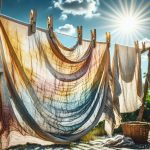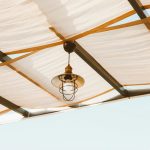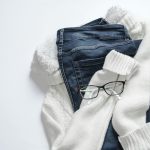When it comes to UV protection, the color of the fabric you choose can make a significant difference. You might be surprised to learn that darker natural fabrics tend to offer more defense against harmful rays compared to their lighter counterparts. This raises important questions about how fabric color, along with other factors, impacts your sun safety. So, what exactly makes darker shades more effective, and how can you make the best choices for your wardrobe?
Table of Contents
Key Takeaways
- Dark fabrics absorb more UV rays than lighter ones, providing better protection against UV radiation.
- The color saturation of fabric influences its UV blocking ability, with darker shades offering enhanced safety.
- Natural fibers like cotton, linen, and wool can improve UV resistance when dyed darker.
- Heavier and tightly woven dark fabrics block more sunlight, further enhancing UV protection.
- Choosing UPF-rated dark natural fabrics is advisable for optimal sun safety during outdoor activities.
Understanding UV Radiation and Its Effects
Understanding UV radiation is essential, especially since it can have significant effects on your skin and overall health.
UV rays come in two main types: UVA and UVB. UVA rays penetrate deeply, leading to premature aging and skin damage, while UVB rays are responsible for sunburn. Exposure to these rays increases your risk of skin cancer, making it vital to protect yourself.
Even on cloudy days, up to 80% of UV rays can reach your skin. It’s important to check the UV index and take precautions, like wearing sunscreen, protective clothing, and seeking shade during peak hours.
The Role of Fabric Color in UV Protection
When choosing fabrics for UV protection, the color matters more than you might think.
Dark fabrics absorb more UV rays than lighter ones, providing better protection for your skin.
Understanding how color influences absorption can help you make smarter choices for sun safety.
Dark vs. Light Fabrics
While light fabrics may feel cooler on a hot day, dark fabrics offer superior UV protection that can be essential for your skin’s health. Choosing the right color can make a difference in how much UV radiation you absorb.
Here are a few things to evaluate when selecting your fabrics:
- UV Absorption: Darker colors absorb more UV rays, preventing them from reaching your skin.
- Skin Protection: Wearing dark fabrics can reduce your risk of sunburn and long-term skin damage.
- Comfort Level: While dark fabrics may retain heat, they often provide better protection.
- Fabric Type: The weave and material also play a role, so assess those factors alongside color.
In the end, it’s about balancing comfort and protection for your outdoor activities.
Color Absorption Properties
The color of your fabric plays an essential role in determining its ability to protect you from harmful UV rays. Darker colors, like deep blues and blacks, absorb more UV radiation compared to lighter shades, which tend to reflect it.
When you wear darker fabrics, you’re fundamentally creating a barrier that reduces the amount of UV light penetrating your skin. This doesn’t mean you should only wear dark colors; the fabric’s weave and thickness also matter.
However, if you want extra protection during sunny days, opting for darker natural fabrics could be a smart choice. Remember, while color is important, always consider the overall fabric quality and whether it’s designed for UV protection.
Stay safe and stylish!
Natural Fibers and Their UV Resistance
Natural fibers, such as cotton, linen, and wool, offer varying degrees of UV resistance, making them a practical choice for sun protection.
When you choose natural fabrics, consider these factors for ideal UV defense:
- Cotton: Generally provides moderate UV protection, especially when tightly woven.
- Linen: Offers higher UV resistance due to its natural structure and breathability.
- Wool: Surprisingly effective against UV rays, with a high natural SPF.
- Hemp: Known for its durability, hemp also boasts impressive UV-blocking capabilities.
Comparing Weave Density and Fabric Weight
When you consider fabric for UV protection, both weave density and fabric weight play essential roles.
Heavier fabrics often provide better coverage, while tighter weaves can enhance UV resistance.
Let’s compare how different materials stack up in these aspects and what that means for your choices.
Fabric Weight Impact
While you might think that color alone determines a fabric’s UV protection, fabric weight and weave density play essential roles as well.
Heavier fabrics generally provide better UV protection because they block more sunlight. Here’s how fabric weight impacts your UV defense:
- Thickness: Thicker fabrics absorb more UV rays, reducing exposure.
- Layering: Heavier materials can create multiple layers, enhancing protection.
- Tightness: Heavier fabrics often have tighter weaves, minimizing gaps for UV rays to penetrate.
- Durability: Heavier fabrics tend to be more durable, maintaining their protective qualities over time.
Weave Density Effects
Although fabric weight contributes markedly to UV protection, weave density can have an equally important effect.
When you consider how tightly the fibers are woven together, you’ll find that higher weave density often leads to improved UV resistance. A tightly woven fabric creates fewer gaps for UV rays to penetrate, providing better coverage. This means that even lightweight fabrics with high density can offer significant protection against harmful rays.
Conversely, loosely woven materials might feel breathable and lightweight but may not shield you effectively from UV exposure.
Comparison of Materials
Understanding the interplay between weave density and fabric weight is essential for selecting materials that offer the best UV protection.
Higher weave density typically means more threads per inch, reducing UV rays’ penetration. However, fabric weight also plays a significant role; heavier fabrics often provide better coverage and protection.
When comparing materials, consider these key factors:
- Weave Density: Tighter weaves block more UV rays.
- Fabric Weight: Heavier fabrics can offer more protection.
- Material Type: Natural fibers like cotton and linen can vary in UV resistance.
- Finishing Treatments: Chemicals or coatings can enhance UV protection.
The Advantages of Darker Colors in Natural Fabrics
Darker colors in natural fabrics offer several advantages that you might find appealing.
First, they tend to absorb more heat, which can be beneficial in cooler weather, keeping you warm and cozy.
Additionally, darker shades often have a richer, more sophisticated look, enhancing your wardrobe’s elegance.
They can also hide stains and dirt better than lighter colors, making maintenance easier.
Furthermore, darker fabrics can provide a more flattering silhouette, boosting your confidence in various settings.
Finally, many darker hues have a timeless quality, ensuring your pieces remain stylish for years to come.
Exploring Hemp as a High UV Protection Fabric
When considering fabrics that combine style with functionality, hemp stands out as a remarkable option for UV protection. This versatile material isn’t just eco-friendly; it also offers impressive benefits.
Here are four reasons why you should consider hemp for UV protection:
- High UV Resistance: Hemp fibers naturally block harmful UV rays effectively.
- Durability: This fabric withstands wear and tear, ensuring long-lasting use.
- Breathability: Hemp allows air circulation, keeping you cool in warm weather.
- Moisture-Wicking: It absorbs moisture, helping you stay dry and comfortable under the sun.
The Limitations of Lighter Natural Fabrics
While lighter natural fabrics like cotton and linen are often favored for their breathability and comfort, they come with significant limitations regarding UV protection. These fabrics typically allow more UV rays to penetrate, increasing your risk of sunburn and skin damage.
| Limitation | Explanation |
|---|---|
| Low UV Protection Factor | Lighter colors absorb less UV, but offer minimal block. |
| Increased Transparency | Thin weaves let more sunlight pass through. |
| Color Reflectivity | Light colors reflect UV, but don’t prevent it from reaching skin. |
| Moisture Retention | Wet fabrics lose any minimal protective qualities. |
| Limited Durability | Frequent washing can degrade UV protection over time. |
Understanding these limitations can help you make better choices for your sun safety.
Making Informed Choices for UV Protective Clothing
To guarantee you stay protected from harmful UV rays, it’s essential to choose clothing that offers adequate coverage and features.
Choosing clothing with proper coverage and features is vital for protection against harmful UV rays.
Here are some key factors to evaluate when selecting UV protective clothing:
- Fabric Type: Opt for tightly woven fabrics that block UV rays effectively.
- Color: Darker colors generally absorb more UV radiation, providing better protection.
- Fit: Loose-fitting clothes can offer more coverage and allow for airflow, reducing heat exposure.
- UPF Rating: Look for garments with a high Ultraviolet Protection Factor (UPF) rating, which indicates their effectiveness against UV rays.
Frequently Asked Questions
How Does UV Exposure Affect Skin Health Over Time?
Imagine your skin as a canvas; over time, UV exposure can paint it with wrinkles, sunspots, and even skin cancer. You need to protect it, or the damage may become irreversible. Prioritize your skin health!
Are There Specific UPF Ratings for Different Fabric Types?
Yes, specific UPF ratings exist for various fabric types. You’ll find that tightly woven and darker fabrics typically provide higher UPF protection. Always check labels to guarantee you’re getting the UV defense you need.
Can Clothing Treatments Enhance UV Protection Effectiveness?
Sure, just douse your clothes in SPF 1000! But seriously, clothing treatments can enhance UV protection effectiveness considerably, adding layers of defense. So, you might want to contemplate those treatments for better sun safety.
What Are the Best Practices for Caring for UV Protective Clothing?
To care for UV protective clothing, wash it gently in cold water, avoid bleach, and line dry away from direct sunlight. Regularly check for damage, and store it in a cool, dry place when not in use.
Does Laundry Affect the UV Protection of Fabrics?
Laundry can affect the UV protection of fabrics. Frequent washing may degrade protective fibers and coatings. To maintain effectiveness, use gentle detergents, avoid fabric softeners, and wash in cold water whenever possible to preserve UV blocking properties.
- Does Chiffon Fabric Stink - July 15, 2025
- Does Chiffon Fabric Affect the Economy - July 15, 2025
- Does Cotton Fabric Have a Nap - July 15, 2025







